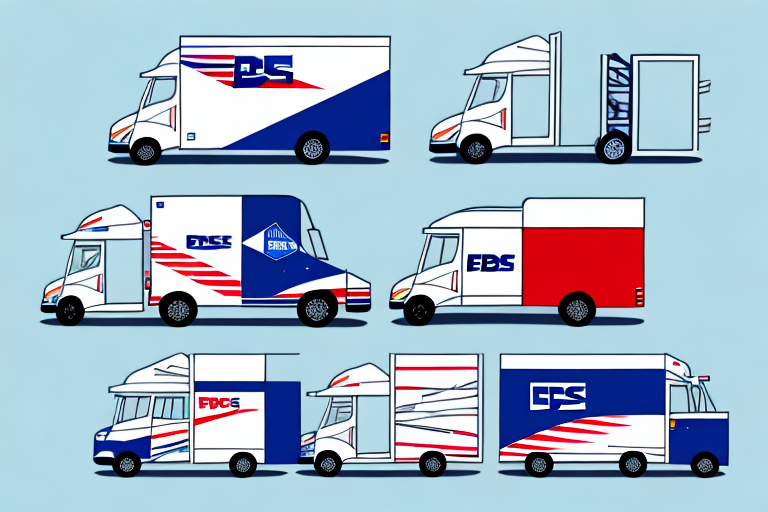Comparing the Lowest Shipping Rates of USPS, FedEx, and UPS
When it comes to shipping, every business aims to minimize costs without compromising on service quality. One of the most effective strategies to achieve this is comparing rates across different carriers to find the best deal. In this article, we compare the rates of three major shipping carriers – USPS, FedEx, and UPS – providing you with comprehensive information to make an informed decision for your business.
USPS Shipping Rates: How Do They Compare to FedEx and UPS?
USPS is often regarded as the most economical option among the three carriers, especially for smaller packages and domestic shipments. Their rates are calculated based on the package's weight and the distance it travels. Generally, USPS offers the lowest rates for domestic shipments under 2 pounds.
According to the USPS Pricing Guide, their Priority Mail service starts at $7.70 for packages under 1 pound, making it a cost-effective choice for small businesses. However, for larger or heavier shipments, especially those requiring international delivery, FedEx or UPS may provide more competitive rates.
Delivery speed is another critical factor. While USPS is budget-friendly, its delivery times may be longer compared to FedEx and UPS, which offer expedited services like overnight and same-day delivery options. Additionally, USPS provides basic tracking and insurance, but the offerings are less comprehensive than those from FedEx and UPS, which offer enhanced tracking and insurance for an additional fee.
FedEx Shipping Rates: How Do They Stack Up Against USPS and UPS?
FedEx is typically seen as a mid-priced carrier, balancing affordability with reliability. Their rates depend on distance, weight, and package dimensions. FedEx is often the best choice for shipments over 2 pounds and for international deliveries.
The FedEx Rate Finder tool allows businesses to estimate shipping costs accurately. For instance, FedEx Ground starts at $8.50 for packages under 1 pound, which is competitive for heavier items that USPS might charge more for.
FedEx offers a variety of delivery options, including same-day, next-day, and 2-3 day services. Their money-back guarantee on express services ensures reliability for time-sensitive shipments. Additionally, FedEx provides business solutions like customized packaging and fulfillment services, which can streamline the shipping process and reduce overall costs.
UPS Shipping Rates: Which Carrier Offers the Best Deals for Your Business?
UPS is generally perceived as a slightly more expensive option, particularly for domestic shipping. However, UPS provides a wide array of services that can be advantageous for certain businesses, such as guaranteed delivery times and access to a vast network of retail locations.
According to the UPS Rate Calculator, UPS Ground starts at $7.50 for packages under 1 pound. For international shipping, UPS is often preferred due to its reliability and comprehensive tracking system, though costs can be higher compared to other carriers.
UPS also offers tools and resources to optimize shipping processes. Their online platform allows for easy creation and printing of shipping labels, package tracking, and account management. Additionally, UPS provides consulting services to help businesses enhance their supply chain efficiency and reduce shipping expenses over time.
How to Choose the Right Shipping Carrier for Your Business Needs
Selecting the appropriate shipping carrier involves evaluating the specific needs of your business and the types of shipments you handle. Consider whether you primarily ship domestically or internationally, and assess the typical weight and size of your packages.
- Evaluate Shipping Volume: Higher shipping volumes may qualify you for volume discounts.
- Assess Delivery Speed Requirements: Time-sensitive shipments may necessitate faster delivery options.
- Consider Additional Services: Services like insurance, tracking, and packaging solutions can add value.
Utilize online rate comparison tools from platforms like ShipStation and Shippo to compare rates across multiple carriers. Additionally, consider factors such as customer service quality, ease of use, and the carrier’s reliability based on delivery success rates and ability to handle unforeseen issues.
Environmental impact is also an increasingly important consideration. Look for carriers offering eco-friendly options like carbon-neutral shipping or the use of electric and hybrid vehicles. This not only reduces your business's carbon footprint but can also appeal to environmentally conscious customers.
Understanding the Different Shipping Options Available from USPS, FedEx, and UPS
Each carrier offers a variety of shipping options and add-ons to tailor shipments to specific needs:
- Insurance: Protects against loss or damage.
- Signature Confirmation: Ensures package is received by the intended recipient.
- Expedited Shipping: Provides faster delivery times for urgent shipments.
Carefully evaluate these options to determine their necessity for each shipment, as unnecessary add-ons can increase overall shipping costs.
Delivery times and reliability vary among carriers. For example, USPS is suitable for smaller, lightweight packages with standard delivery times, while FedEx and UPS are better for larger, heavier packages requiring secure handling and faster delivery.
Customer service and support are also crucial. In cases of lost or damaged packages, prompt and effective customer service is essential. Research and read customer reviews to gauge the quality of support offered by each carrier before making a decision.
Pros and Cons of Using USPS, FedEx, and UPS for Your Shipping Needs
- USPS:
- Pros: Most affordable for small, domestic packages; extensive delivery network.
- Cons: Limited tracking and insurance; slower delivery times.
- FedEx:
- Pros: Balanced affordability and reliability; excellent for heavier and international shipments; various delivery speed options.
- Cons: Higher rates for smaller packages.
- UPS:
- Pros: Highly reliable, especially for international and time-sensitive deliveries; robust tracking system.
- Cons: Generally higher rates, particularly for small shipments.
Factors to Consider When Choosing a Shipping Carrier: Speed, Cost, Reliability, and Convenience
When selecting a shipping carrier, evaluate the following key factors:
- Speed: Essential for time-sensitive deliveries.
- Cost: Balance between affordable rates and service quality.
- Reliability: Consistent delivery success rates and handling of unforeseen issues.
- Convenience: Accessibility of drop-off locations and ease of using carrier services.
Prioritizing these factors based on your business needs will help you choose the most suitable carrier.
Tips for Negotiating Better Shipping Rates with USPS, FedEx, or UPS
To reduce shipping costs, consider the following strategies:
- Volume Discounts: Negotiate for lower rates based on high shipping volumes.
- Consolidate Shipments: Batch multiple orders to qualify for bulk shipping rates.
- Use Online Shipping Platforms: Platforms like ShipStation offer discounted rates through partnerships with carriers.
- Optimize Packaging: Use appropriately sized packaging to avoid dimensional weight charges.
Engage in direct discussions with carriers to explore custom rate agreements tailored to your business's shipping patterns.
How to Save Money on Shipping Costs by Comparing Rates Across Multiple Carriers
One of the most effective ways to minimize shipping expenses is by comparing rates across multiple carriers. Utilize online platforms such as ShipStation and Shippo to easily compare rates and services from USPS, FedEx, and UPS side by side. By analyzing these comparisons, you can identify the most cost-effective option for each specific shipment.
Additionally, regularly reviewing your shipping practices and staying informed about carrier promotions or rate changes can lead to significant savings.
Common Mistakes to Avoid When Choosing a Shipping Carrier for Your Business
- Not Comparing Multiple Carriers: Relying on a single carrier may result in higher costs.
- Ignoring Additional Fees: Overlooking surcharges and fees can inflate shipping expenses.
- Neglecting Delivery Times: Inadequate consideration of delivery speed can affect customer satisfaction.
- Overlooking Reliability: Choosing based solely on cost without considering carrier reliability can lead to service issues.
By being aware of these common pitfalls, you can make more informed decisions and optimize your shipping strategy effectively.
Case Studies: Real-Life Examples of Businesses That Saved Money by Switching to a Different Carrier
Real-life examples demonstrate the potential savings from switching carriers:
- Small E-commerce Business: By switching from USPS to FedEx, a small e-commerce store saved over $50,000 annually on shipping costs, benefiting from better rates on heavier packages and improved delivery times.
- Contract Embroidery Business: Transitioning from UPS to USPS allowed a contract embroidery firm to save over $7,000 per year, taking advantage of USPS's lower rates for smaller shipments and extensive domestic network.
These case studies highlight the importance of regularly reviewing and optimizing your shipping carrier choices to achieve significant cost savings.
Future Trends in the Shipping Industry: What Should You Expect from USPS, FedEx, and UPS?
The shipping industry is evolving with several emerging trends:
- Automation and Digitization: Increased use of automated sorting and robotics to enhance efficiency.
- Sustainability: Greater emphasis on eco-friendly practices, such as carbon-neutral shipping and the use of electric vehicles.
- Enhanced Delivery Options: Expansion of same-day and next-day delivery services to meet consumer demand.
- Improved Customer Experience: Focus on better tracking systems and customer service to enhance user satisfaction.
Staying informed about these trends can help businesses adapt their shipping strategies and leverage new opportunities as they arise.
How to Track Your Shipments with USPS, FedEx, or UPS
Tracking your shipments is crucial to ensure timely and safe delivery. Each carrier provides comprehensive tracking systems:
- USPS: Use the USPS Tracking tool by entering your tracking number on their website or mobile app.
- FedEx: Access the FedEx Tracking feature through their website or app by inputting the tracking number.
- UPS: Utilize the UPS Tracking service on their platform with your tracking number.
These tools offer real-time updates on your package's status, providing peace of mind and allowing you to manage delivery expectations effectively.
Customer Service Comparison: Which Carrier Provides the Best Support?
Customer service quality varies among carriers and can significantly impact your shipping experience:
- USPS: Known for its affordability, USPS customer service can have longer wait times and less comprehensive support compared to other carriers.
- FedEx: Offers robust customer support with multiple contact options, including phone, email, and live chat, ensuring prompt assistance.
- UPS: Provides extensive customer service resources, including a dedicated support team and various online tools for managing shipments.
Choosing a carrier with reliable and accessible customer support is essential, especially for resolving issues related to lost or damaged packages and managing complex shipping needs.
In conclusion, selecting the right shipping carrier is a multifaceted decision that requires careful analysis of rates, services, reliability, and customer support. By thoroughly comparing USPS, FedEx, and UPS based on your business’s unique requirements, you can optimize your shipping strategy to save money and enhance customer satisfaction.




















